Bike noises such as creaks, squeaks, squeals and clicks are more than just annoying when you're riding your bike: they may indicate a serious problem that, left unfixed, could result in injury to you and/or damage to your bike.
Finding where noises originate can sometimes be difficult. Try your best to identify where you think the noise is coming from, then attempt to eliminate the problem.
Diagnosing and repairing the most common bike noises requires beginner to intermediate knowledge of bike parts and how they work. If you're not sure how to fix something, take your bike to your local shop for service.
How to Fix Bike Chain Noises
How to fix a Squeaky Chain
A squeaky chain needs to be lubed. Do this by placing the bike in a stand or by leaning it against a wall with the drivetrain facing you so that the pedals can spin freely. Drip a drop of lube on each chain link as you pedal backwards with your hand. Continue to pedal backwards to work in the lube.
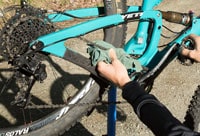
Before your next ride, wipe off any excess lube with a clean rag using the same positioning and backwards pedaling.
If your chain is severely rusty or has stiff links, take it to a bike shop to have the chain replaced.
Learn more about cleaning and maintaining your bike chain in our article, Bike Chain Cleaning and Maintenance.
How to Fix a Clicking Chain
A clicking noise often comes from your chain wanting to jump up or down a gear on the rear cassette. This can typically be fixed by adjusting the tension of the cable that runs from your shifter to your rear derailleur. Depending on the style of your bike, there will be barrel adjusters located on the shifters, cables and/or near the rear derailleur. Use the barrel adjusters to fine-tune the cable tension.
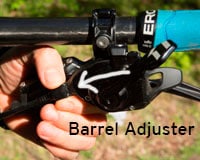
Turn the barrel adjuster ¼ turn at a time. Turn the adjusters clockwise if the chain seems to want to fall into a smaller cog. Turn the barrel adjuster counter-clockwise if the chain won't shift up to the larger cog.
If you've turned the barrel adjuster more than a full turn and it hasn't solved the problem, see a bike technician. The clicking could be caused by a bent derailleur hanger.
How to Fix Squeaky Bike Brakes
Squeaking brakes are one of the few squeaks that you don't fix with lube. Never lube your brakes.
First, check if your wheel is properly attached: Before attempting to silence a squeak, make sure your wheel is properly seated in the dropout of your front fork or rear part of the frame. A wheel that is not seated properly will be off-kilter and may rub against one brake pad or part of the frame.
Next, check if your wheel is true: To make sure your wheel is true (not wobbling side to side), put your bike in a stand or lift the squeaky wheel off the ground and spin the wheel.
If you have rim brakes, watch the rim and the brake pads. If you see wobble or inconsistent rubbing between the rim and brake pads, your wheel needs truing.
If you have disc brakes, watch the rotor and brake pads. If you see wobbling and rubbing, either your wheel needs truing or you may have a bent rotor.
If your wheel needs truing, or you have a bent rotor, take your bike to the shop. If your wheel is true, you can proceed to the next steps.
Check for dirt and wear: Try cleaning the pads and rim or rotor with rubbing alcohol or a cleaner designed specifically for brakes. Then rough the pads and rotor lightly with sandpaper (with disc brakes, it will be easiest if you remove the pads from the calipers before sanding them).
Then, check that your brake pads haven't worn down too much. There needs to be enough pad that the metal piece that holds the pads won't touch your rim or rotor.
Most pads for rim brakes have markings to show when they need to be replaced.
Check disc brake pads by removing the wheel and looking into the space where the rotor spins, or by removing the pads themselves. As a general guideline, disc brake pads should be replaced if the pad thickness, including the metal holder, is less than 3mm. Be careful not to squeeze the brake lever when the wheel is off.
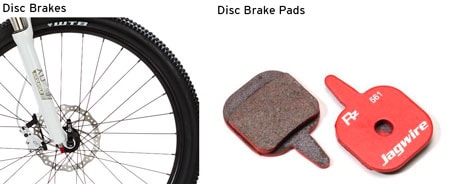
Check the alignment of your rim brake pads: If your rim brake pads are hitting the rim flat, that will make them squeak when you're braking. Reposition them using a hex wrench so that the front of each pad contacts the rim slightly before the rear of each pad. This is called toeing the pads in.
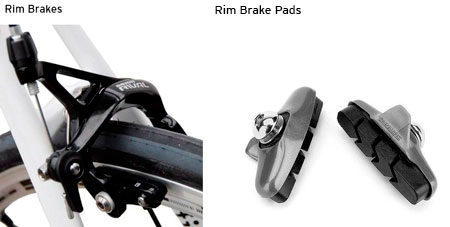
Whether you have disc brakes or rim brakes, if your brake pads are off-center, it's best to take your bike to a shop to have them adjusted. Off-center brakes cause one side of the brakes to make contact with the rotor or rim before the other one does, resulting in poor braking power.
How to Fix Rear-Suspension Pivot Noises
The rear suspension on a mountain bike has multiple pivot points that can develop squeaks when they're loose or dry, or when the bearings need to be replaced.
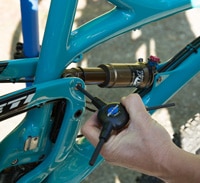
Check if the pivots are tight using the appropriate size hex wrench for the pivot bolts. Pivot bolts should be tightened to the bike manufacturer's specifications using a torque wrench.
Drip lube into the joint between the pivot and the frame. Check for play by grasping the internal piece of the pivot and wiggling it side to side. If lube and tightening don't solve the squeak, take your bike in for service.
How to Fix Front-Suspension Noises
How to Fix a Squeaky Bike Suspension
If your front shock is squeaking, you may have it accidently locked out when you're riding technical terrain. This can cause a sneeze-like squeak. Open your shock to the ride position on technical terrain to eliminate the noise.
How to Fix a Clunking Bike Suspension
If your front shock is clunking, you may need to add pressure to it. For detailed instructions, see our blog post on setting your shocks.
If these solutions don't solve the problem, or if your shock is leaking a significant amount of oil, take your bike in for service.
How to Fix a Squeaky Bike Saddle
Usually squeaks coming from your saddle indicate that the saddle clamp that attaches to the rails of your saddle needs to be tightened. Look under your saddle to determine how it attaches—with one or two bolts on the fore and/or aft sides of your seat post or on the side(s).
Using a hex wrench or star-shaped torx wrench—whichever is compatible with your saddle bolt(s)—tighten the bolt or bolts to eliminate any movement.
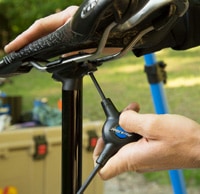
Also confirm that the saddle clamp is within the fore and aft limits of the seat. Most saddles have marks on the rails that show maximum forward and rear positions.
If your saddle is tight but it tips forward or backward, or if it continues to squeak, see a bike mechanic. You may have a worn or defective saddle clamp, or your saddle may need to be replaced.
How to Fix a Creaky Bike Seat Post
If a creak is coming from your seat post, not your saddle, it likely needs lube. If your seat post is aluminum, remove it by loosening the bolt at the seat collar and wipe off any grease and grit. Then, apply a light coating of paste grease with your finger and put the post back in your bike frame. If your post is carbon, use a carbon fiber paste, not grease.
How to Fix a Squeaky Bike Crank
The most common cause of a squeaky crank is that the bolt is loose. Check for play in your cranks by pulling on one side and trying to wiggle it side to side. If there is play, check that your crank bolts are tight using a hex wrench—bolts should be hand-tight.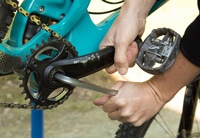
If tightening the bolt doesn't eliminate the squeak, or if you have play even when the bolts are tight, have your bike serviced at a shop.
How to Fix a Squeaky Bike Derailleur
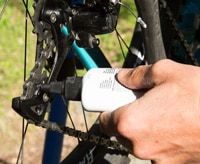
Dry pulley wheels can cause your rear derailleur to squeak. First clean them with a pre-moistened bike-specific cleaning towel or diluted citrus cleaner and a rag and/or cleaning brush—a toothbrush works great. Use a drop of lube on the axis of each pulley wheel, then spin the pedals to turn the wheels and work in the lube. Also place a drop of lube on the hinges of the front and/or rear derailleur to keep parts moving freely.
How to Fix a Rattling Bike Headset
Headset bolts can loosen over time, resulting in wobbly steering and rattling noise. Check for a loose headset by placing your bike on the ground, engaging the front brake and rocking the bike front to back. If you feel a clunking, you may have a loose headset.
Step 1: Using a hex wrench, loosen the two horizontal pinch bolts on your stem.
Step 2: Gently tighten the headset cap bolt. If you tighten it too much, you'll feel resistance when you turn your handlebars side to side and may notice a squeaking noise when you ride. Once you have the right tension, retighten the side bolts.
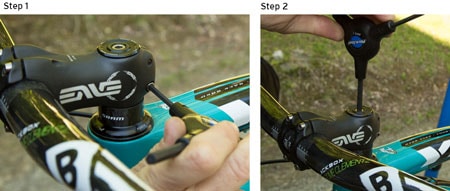
Then, with the bike on the ground, sandwich your front wheel between your legs and aggressively try to turn the handlebars side to side. If they move independently of the wheel, you need to re-loosen the side bolts and retighten the center bolt.
Be aware that clunking in bikes with front suspension can be caused by bushings in the suspension rather than a loose headset. If you follow the steps above and still feel clunking, take your bike to a qualified bike tech for a thorough inspection.
How to Fix Creaky Bike Pedals
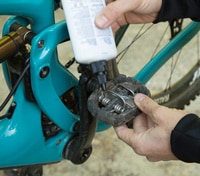
Place a drop of lube on your pedal springs and at the joint in the spindle. Wipe off excess lube. If your pedals are grinding or stiff, you may need your bearings serviced at your local bike shop.
If lubing the pedal springs doesn't eliminate the creaking, check to make sure the cleats on your bike shoes are tight. Loose cleats can cause creaking.
How to Fix Creaky Bike Handlebars
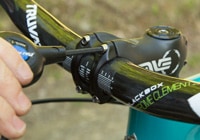
If you have any up and down play and creaking in your handlebar, you need to tighten your stem bolts. With the front wheel between your legs, or the bike in a stand, use a hex wrench to hand tighten the four bolts at the center of your handlebar where it attaches to the stem. Check that top and bottom and left and right bolts are all tightened roughly evenly.
If this solution doesn't eliminate the creak, have your bike checked out by a qualified bike technician. It's possible the creaking is caused by a crack.
How to Fix Squeaky Bike Brake Levers and Shift Levers
If your shift or brake levers are squeaking, add a drop of lube to the cable—accessible when the brake lever is engaged, or when the shift lever is pressed.
How to Fix Rattling Bolts
Bikes have lots of bolts and any one of them can work loose and rattle while you're riding. If you hear rattling, try to locate where it's coming from and make sure all bolts in that area are snug. Be sure to check the bolts that hold your bottle cage to your bike frame. A loose bottle cage can make a lot of noise.
General Bike Maintenance Advice
- Get your bike serviced annually at your local REI or other bike repair shop. A qualified bike mechanic will address clicks, creaks and squeaks before they become a problem.
- Keep your bike clean and well lubed to help reduce wear and tear and squeaks and creaks. See our articles, Basic Bike Maintenance and How to Clean a Bike, to learn more.
- Keep a tube or tub of paste grease on hand, as well as a bottle of liquid lube suited for the conditions where you ride. Always use bike-specific lubes and cleaners.
- The only way to make sure all the bolts on your bike are tightened to manufacturers' specifications is to use a torque wrench. How tight bolts should be is often noted right next to the bolt, whether it's on your rotor or your stem. Set the recommended torque on the wrench, tighten the bolt and when the proper tightness is achieved the wrench will release pressure. Don't confuse an adjustable torque wrench with a torx wrench, which is a star-shaped bit wrench.
